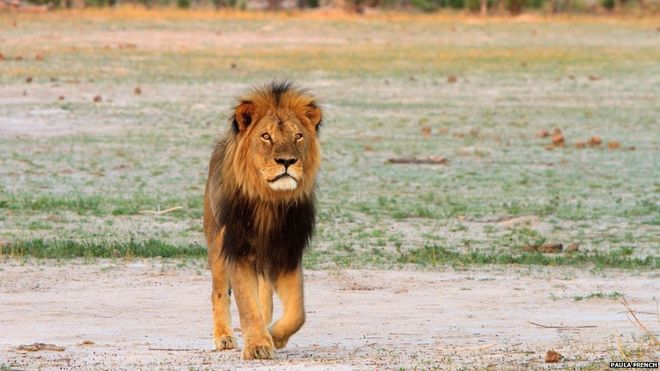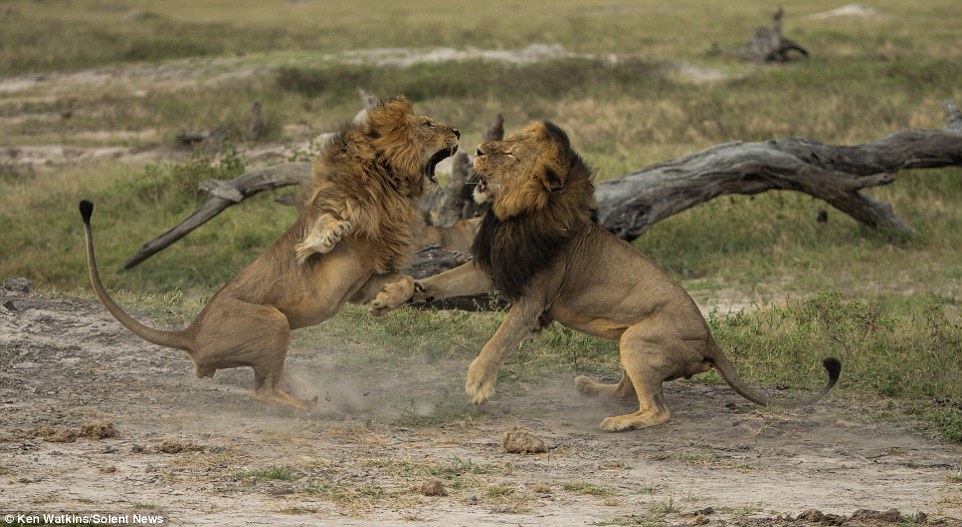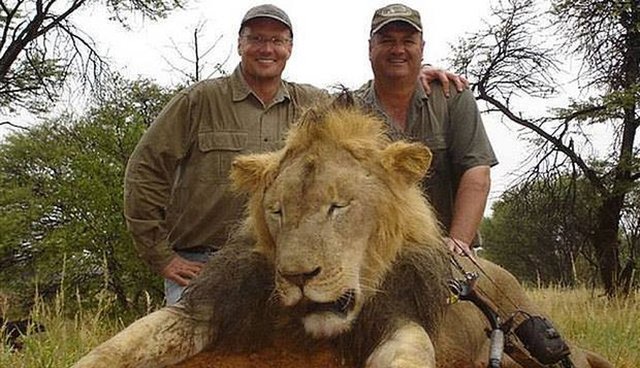Cecil the lion
A TRAGIC DEATH RELEASES WILD EMOTIONS
Cecil the lion
Cecil's death brought international attention to trophy hunting..and unwanted attention to a certain dentist from USA.
Cecil (c. 2002 – 2 July 2015) was a lion who lived primarily in the Hwange National Park in Matabeleland North, Zimbabwe. He was a well-known attraction of the park and was being studied and tracked (using a radio-collar) by a researcher team of the University of Oxford as part of a long-term study.
On the night of 1 July 2015, Cecil was wounded with an arrow by Walter Palmer, an American dentist and recreational big-game hunter, then tracked and killed with a bow and arrow the following morning, between 10 and 12 hours later. Cecil was 13 years old when killed. Palmer had a permit and was not charged with any crime.
The killing resulted in international media attention, caused outrage among animal conservationists, criticism by politicians and celebrities and a strong negative response against Palmer.
Background:
During 2009 Cecil, and a lion thought to be his brother, encountered and attempted a takeover of a pride which resulted in a fight in which Cecil's brother was killed, and both Cecil and the leader of the pride were seriously wounded; the leader was subsequently killed by park rangers because of the wounds he had incurred during the fight with Cecil. Cecil retreated to another part of the park where he eventually established his own pride which had as many as 22 members. During 2013, Cecil was forced out from the area by two young male lions into the eastern border of the park. There, he created a coalition with another male lion, named Jericho, to establish two prides which consisted of Cecil, Jericho, half a dozen females and up to a dozen cubs sired by Cecil or Jericho.
Cecil was a well-known animal in the national park and was identifiable by his black-fringed mane and a GPS tracking collar. The lions in the park, including Cecil, have been studied by scientists from the Wildlife Conservation Research Unit at the University of Oxford as part of a scientific project that has run since 1999,[17] and his movements had been followed since 2008.[18] Of the 62 lions tagged during the study period, 34 have died, thereof 24 through sport hunting. Of adult male lions that were tagged inside the park, 72% were killed through sport hunting on areas near the park. One of the researchers on the project suggested that Cecil had become so popular because he was accustomed to people, allowing vehicles sometimes as close as 10 metres (33 ft), making it easy for tourists and researchers to photograph and observe him.
During June 2015, Dr. Walter J. Palmer, an American dentist and recreational game hunter from Minnesota, reportedly paid US$50,000 to a professional hunter-guide, Theo Bronkhorst, to enable him to kill a lion. In the late afternoon of 1 July, Bronkhorst and tracker Cornelius Ncube 'baited' and built a hunting blind in Atoinette Farm, a private property owned by Honest Ndlovu. Between 9 pm and 11 pm, Palmer shot and wounded Cecil with an arrow. The hunters tracked the wounded lion and killed him with a second arrow the next morning (about 10 to 12 hours later) at a location less than 250 metres from the initial shot. The hunt took place outside Hwange National Park, a protected area, but part of the lion's normal range. Cecil's body was then skinned and his head removed. When the lion's headless skeleton was found by park investigators, his tracking collar was missing.
Cecil had been equipped with a satellite tracking device from which locational data were recorded every 2 hours. Subsequently, location data was pieced together and is depicted in the map herein. This interpretation of events was corroborated by the subsequent investigation by Zimbabwe National Parks and Wildlife management and is consistent with the satellite data.
Bronkhorst said during July, "We had obtained the permit for bow hunting, we had obtained the permit for the lion from the council." The two Zimbabweans were arrested by Zimbabwe police. Palmer had already returned to the United States, where he issued a statement that he had "relied on the expertise of my local professional guides to ensure a legal hunt" and "deeply regret that my pursuit of an activity I love and practice responsibly and legally resulted in the taking of this lion".
Cecil's killing created an outrage among animal conservationists, and prompted responses from politicians and many other people. A number of celebrities publicly condemned Cecil's killing. Palmer received a large number of hate messages, and activists posted his private details online. The words "Lion Killer" were also spray-painted on the garage door at Palmer's Florida vacation home. In addition, at least seven pickled pigs feet were left on the residence. Artists from around the world dedicated art to Cecil, including Aaron Blaise, a former artist of Walt Disney Feature Animation.[38] Musicians composed original works to honor Cecil.
The killing of Cecil sparked a discussion among conservation organisations about the ethics and business of big-game hunting and a proposal for bills banning imports of lion trophies to the U.S. and European Union. These discussions have convinced three of the largest airlines in the U.S., American, Delta and United, to voluntarily ban the transport of hunting trophies. In response, by the premise that profits from trophy hunts help animal conservation efforts, Pohamba Shifeta, the Namibian environment and tourism minister, said, "This will be the end of conservation in Namibia." Activists have also asked African countries to ban bow hunting, lion baiting, and hunting from hunting blinds. Global media and social media reaction has resulted in close to 1.2 million people signing online petition "Justice for Cecil", which asks Zimbabwe's government to stop issuing hunting permits for endangered animals.
Safari Club International responded by suspending both Palmer's and Bronkhorst's memberships, stating that "those who intentionally take wildlife illegally should be prosecuted and punished to the maximum extent allowed by law." Late-night talk-show host Jimmy Kimmel helped raise US$150,000 in donations in less than 24 hours to Oxford's Wildlife Conservation Research Unit, which had been "responsible for tracking Cecil's activity and location".
Cecil's killing went largely unnoticed in the animal's native Zimbabwe. The country's The Chronicle newspaper wrote: "It is not an overstatement that almost 99.99 percent of Zimbabweans didn’t know about this animal until Monday. Now we have just learnt, thanks to the British media, that we had Africa’s most famous lion all along, an icon!" The BBC's Farai Sevenzo wrote: "The lion's death has not registered much with the locals". At the same time, Zimbabwean officials stated that the killing of Cecil had already caused a decrease of tourism revenues. A significant decrease was noted in Hwange, where the lion had lived. Many international tourists, who had planned to see the lion, had cancelled their trips. "This killing is a huge loss to our tourism sector that was contributing immensely to the national wealth", said Emanuel Fundira, the president of the Safari Operators Association of Zimbabwe. "We had a lot of people, in terms of visitors, coming in to the country to enjoy and view Cecil, so really this was a great loss," Fundira said, and that Cecil's presence was "a draw card," and compared his death to "the demise of an icon". The director of the Zimbabwe Tourism Authority, Karikoga Kaseke, said that tourism had been booming, but that Zimbabwe was now perceived as a country which was not interested in protecting and promoting animal rights, and this had also had a negative effect on the tourism sector.
On 1 August 2015, in response to Cecil's killing, the hunting of lions, leopards and elephants along with all bow-hunting was immediately suspended in areas outside of Hwange National Park by Zimbabwe's environment minister, Oppah Muchinguri, who said, "All such hunts will only be conducted if confirmed and authorized in writing by the Director-general of the Zimbabwe Parks and Wildlife Management Authority, and only if accompanied by parks staff whose costs will be met by the landowner". The moratorium was lifted after 10 days.
Five months after the killing of Cecil, the U.S. Fish and Wildlife Service added two species of lions, in India and western and central Africa, to the endangered species list. The listings would make it more difficult (though not impossible) for US citizen hunters to kill these protected lions. According to Wayne Pacelle, president of the Humane Society of the United States and who petitioned for the new listing, Cecil had "changed the atmospherics on the issue of trophy hunting around the world," adding "I think it gave less wiggle room to regulators." Wayne added that he thought the killing of Cecil was "a defining moment" resulting in the new protections. Jeff Flocken, regional director of the International Fund for Animal Welfare, said that while the U.S.F.W.S. decision was not the direct result of the death of Cecil, "it would be impossible to ignore the public outcry" and its effect on worldwide opinion. The New York Times, writing about the new regulations, said "the killing of Cecil .. seemed to galvanize public attention."
Other countries and companies have also taken action. In the five months since Cecil's killing, France banned the import of lion trophies. The Netherlands did so in 2016. Britain said it will do so during 2017. More than 40 airlines have also said they will no longer transport hunting trophies. The investigative journalist George Knapp noted Cecil's case on the approach of the incident's one-year anniversary during an annual animal-welfare broadcast concerning issues, the development of law, animal cruelty, and remediation efforts in June 2016. The 2016 broadcast covered various issues, including horses and trophy hunting noting Cecil and the effect the incident was still causing at the date of the show. Money raised in response to Cecil's death has been used by researchers to reduce conflicts between people and lions by paying for lion protectors and other methods.Courtesy: Wikipedia
THE TRAGEDY - PART 2.
Cecil‘s oldest son, six-year-old Xanda, was been killed by a trophy hunter in July 2017.
According to The Guardian, Xanda was shot outside the Hwange National Park in Zimbabwe by trophy hunters not far from where Cecil perished.
This tragic death comes just two years after Cecil was lured out of the same animal reserve and killed by Minnesota dentist Dr. Walter Palmer as part of a game hunt, causing global outrage that led to the temporary shut down of Dr. Palmer’s office.
Xanda’s death was the result of a game hunt organized by a private hunter. The identity of the client, who likely paid thousands for the opportunity to kill Xanda and other African mammals, have not been revealed.
There is little that can be done legally in response to the lion’s death, since he was shot outside Hwange National Park. Andrew Loveridge, the Oxford University scientist who fitted Xanda with a tracking collar, knew Cecil’s son and other lions were spending a growing amount of time outside the park but told The Daily Telegraph, “there is not much we can do about that.”
It is a sad inditement of the trophy hunting industry that a male lion, in this case just 6 years old, had suffered such a fate and leaving small cubs unprotected and unlikely to survive.
THE TRAGEDY CONTINUED in 2021.
Lion ‘Mopane’ killed by hunters in Zimbabwe, August 2021: A male lion known as Mopane has been killed in a hunting area on the outskirts of Hwange National Park. Reliable sources say that the lion was targeted by a bow hunter in the same area that renowned lion Cecil was killed in 2015. Reports confirm that the hunt was legal and that the necessary permits were in place.
Mopane was a 12 year old pride male with a litter of six cubs. The identity of the professional hunter and the client have yet to be confirmed.
Almost every year, a dominant pride male resident between the park and the boundary farms is taken out by hunters. There is significant impact on pride dynamics as a result. Males taken out of a pride often cause conflict as other males move in resulting in the loss of lionesses, less dominant males or cubs which are killed by the new males. Dispersal of youngsters fleeing into external areas creates potential human-wildlife conflict with communities living on the borders of the park. 20 lions have been killed in this area over the past decade. Many argue that the current level of lion hunting is not sustainable in the area bordering Hwange National Park. Before he was targeted, Mopani had formed a coalition with another male named Sidhule. On 10 August 2019, World Lion Day, Sidhule was shot and killed by hunters on the outskirts of the park. Source: Getaway magazine.ARTICLES OF INTEREST:
Trophy hunters kill another breeding Hwange lion – Mopane August 2021.
Conversations with Beks: The Story of Cecil & His Pride (video) 2020.
Cecil the Lion one Year on: An Interview with Cecil’s Researcher, July 2016 (PDF).
One Woman's Remarkable Journey to Protect Lions (Video).
Go back to: Families & Species Ambassadors



